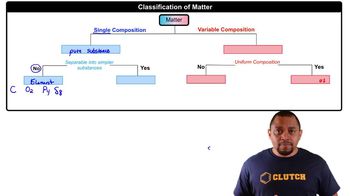Textbook Question
What is the mass in grams of each of the following samples? (b) 0.0015 mol of lead
 Verified step by step guidance
Verified step by step guidance



What is the mass in grams of each of the following samples? (b) 0.0015 mol of lead
What is the mass in grams of each of the following samples? (c) 0.0015 mol of diazepam (Valium), C16H13ClN2O
A sample that weighs 25.12 g contains 6.022⨉1023 particles. If 25.00% of the total number of particles are argon atoms and 75.00% are another element, what is the chemical identity of the other constituent?
Titanium metal is obtained from the mineral rutile, TiO2. How many kilograms of rutile are needed to produce 100.0 kg of Ti?